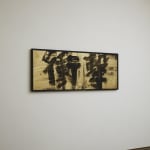Suda Kokuta (1906−1990)
Shōgeki (shock)
Ink on golden paper, framed
Dated 1988
With a label signed by the artist, a Suda Kokuta kantei iinkai certificate
57 x 153 cm
61 x 157 cm (overall)
Further images
A great turning point in Suda Kokuta’s artistic career took place around 1958, when he joined Tensekikai, an artist and intellectual group led by the anesthetist Ijima Tsutomu. A recognized pioneering figurative artist at the time, at Tensekikai Kokuta met Hasegawa Saburo, Yoshihara Jiro, Morita Shiryu, and others, with whom discussions and communications on abstract paintings, theories and practices aspired him to throw himself to abstraction. He was also introduced to the works of great calligraphy masters, such as Wang Xizhi, Yan Zhenqing, Daito-kokushi, Hakuin Ekaku, as well as the Northern Wei dynasty Buddhist statuary inscriptions, which gave Kokuta significant influence.
It was not until 1981, a decade before his death, that Kokuta concentrated on making his own calligraphic work. Trained as a painter, Kokuta’s sensitiveness to line and form gives his calligraphy a distinctive style that provides the character of meaning an unconventional structure. The present work is executed in 1988, nearly the end of the artist’s life. Kokuta paints the two characters “sho-geki” (shock) at a large scale on the gold ground. Outlines are visible on part of the right character. For Kokuta, strokes usually considered as lines are seen as black color blocks. Just as the artist himself states, “for a painter, calligraphy is painting instead of writing,” this work represents Kokuta’s aesthetics born out of his artistic experience as a painter.
Suda Kokuta (yoga painter; 1906–1990)
Saitama-born yoga painter. His real name is Katsusaburo. Active in major exhibitions such as Bunten, Nitten, the Contemporary Art Exhibition of Japan, and other international exhibitions. His works are infused with ceaseless energy in a distinctive and vigorous style. Also worked in the medium of calligraphy and ceramics. Produced illustrations for a series of travel essays entitled Kaido wo yuku (On the highways) by Shiba Ryotaro, which won the Kodansha publishing culture award. Member of Kokuga-kai.
It was not until 1981, a decade before his death, that Kokuta concentrated on making his own calligraphic work. Trained as a painter, Kokuta’s sensitiveness to line and form gives his calligraphy a distinctive style that provides the character of meaning an unconventional structure. The present work is executed in 1988, nearly the end of the artist’s life. Kokuta paints the two characters “sho-geki” (shock) at a large scale on the gold ground. Outlines are visible on part of the right character. For Kokuta, strokes usually considered as lines are seen as black color blocks. Just as the artist himself states, “for a painter, calligraphy is painting instead of writing,” this work represents Kokuta’s aesthetics born out of his artistic experience as a painter.
Suda Kokuta (yoga painter; 1906–1990)
Saitama-born yoga painter. His real name is Katsusaburo. Active in major exhibitions such as Bunten, Nitten, the Contemporary Art Exhibition of Japan, and other international exhibitions. His works are infused with ceaseless energy in a distinctive and vigorous style. Also worked in the medium of calligraphy and ceramics. Produced illustrations for a series of travel essays entitled Kaido wo yuku (On the highways) by Shiba Ryotaro, which won the Kodansha publishing culture award. Member of Kokuga-kai.





